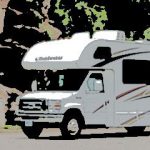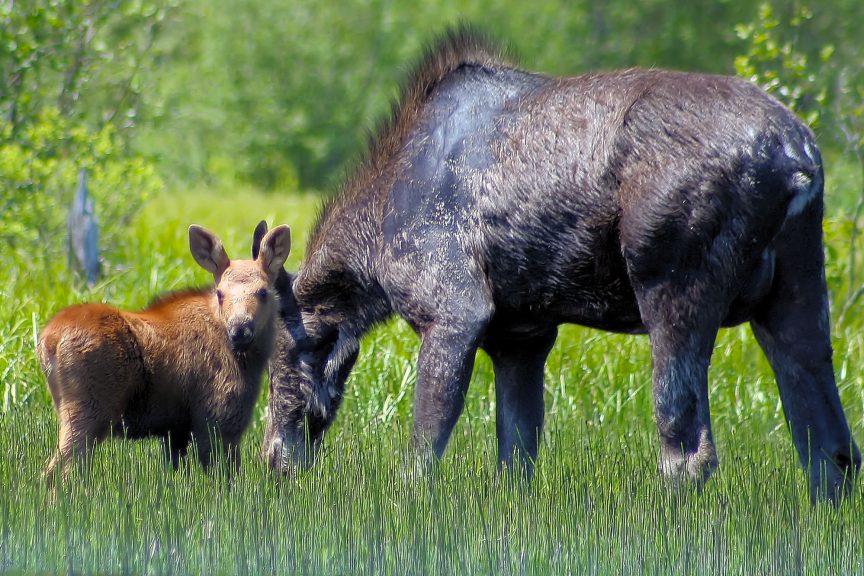Algonquin Provincial Park is located about 30 minutes (approx. 40 km) from Huntsville, in Ontario.
Algonquin Park was created in 1893. It is Ontario’s oldest and most famous provincial park.
For many people, a visit to Algonquin Park can be divided into 2 experiences.
- One is the vast interior (backcountry) that is accessible by foot or canoe with 140 km of backpacking trails and over 2000 km of canoe routes.
- The other Algonquin is the developed areas along the Highway 60 Corridor. It is here that you can stay in traditional car campgrounds; explore museums, stores, restaurants, and walking trails; and take part in interpretive educational programs.
Highway 60 Corridor in Algonquin Park
A 56 km strip along Highway 60 in the southwestern part of the park that includes:
- 8 campgrounds
- 2 museums
- 15 walking trails
- 2 bicycle trails
- picnic areas, outfitting stores, restaurants and lodges.
Site Review:
Of the campgrounds that you can access along the corridor, only 5 of them offer electrical hook-up. There are no sites with water or sewer hook-ups in Algonquin Park at all.
Mew Lake Campground and Two Rivers Campground are very close together and offer a combined 370+ sites. Mew Lake campground is open all year round.
For this review, I am going to focus on Rock Lake Campground and Pog Lake Campground.
Rock Lake Campground in Algonquin Park:
Rock Lake Campground is located at kilometre 40.3 along the Highway 60 Corridor. You turn here and then proceed another 8 km down a gravel road to reach the campground. The road is wide and can accommodate all equipment.
There are 2 sections to the Rock Lake campground. Section A has sites #1-72 and all of these sites have electrical hook-up. The sites in Section B do not have electrical hook-ups and tend to be more suited to tents and smaller equipment.
We stayed on site #54. This site had a nice view of Rock Lake and easy beach access for swimming or launching canoes/kayaks.
The problem with the sites at Rock Lake campground is that there is no privacy between the sites at all. The site boundaries are indicated by logs laid out on the ground.
The best electric site at Rock Lake Campground is site #61.
The comfort stations are close by, clean and the standard you would expect at Ontario Provincial Parks.
Pog Lake Campground at Algonquin Park:
Pog Lake Campground is at kilometre 37 along the Highway 60 Corridor. The sites at Pog Lake campground have more privacy and are in a treed setting.
It’s more of what I expect from provincial park sites compared to the sites at Rock Lake Campground. We had site 117 in Campground A.
It should be noted that there are only 2 dump stations to service the corridor campgrounds. One is at km 35 (which is the one you would use if you camped at Pog Lake campground) The other one is actually at the Rock Lake campground.
Activities at Algonquin Park:
Algonquin Park is the crown jewel of the Ontario Provincial Park system. It is renowned for its canoe routes; for its hiking trails; and for its wildlife.
Canoeing:
The possibilities are vast if you are interested in incorporating a canoe day trip into your RV camping experience- and you really should, this is the place to do it!
Biking:
Both Pog Lake campground and Rock Lake campground access the Old Railway Bike Trail.
Hiking:
There are 15 interpretive walking trails with varying degrees of difficulty that can be accessed from the Highway 60 Corridor.
Logging Museum:
At km 55, you will find the Algonquin Logging Museum. The museum and walking trail depict a time in Algonquin Park history when logging was paramount.
Visitor Centre:
The Visitor Centre is located at km 43.
There are exhibits featuring animals in re-creations of their natural surroundings and others focusing on the park’s cultural history.
Wildlife Viewing:
Moose:
They are attracted to the highway especially during May and June to drink the slightly salty water in the roadside ditches (salty due to winter road operations).
Beaver:
Best viewed in October when they repair their dams and stock their winter food piles; at this time they are often active during the day.
Black Bear:
Black Bears are reasonably common in Algonquin Park, with a population of around 2000 ( 1 for every 3 square kilometres), there is no perfect place to view them and you will be very lucky to see one (In the dozens of times I have been to Algonquin Park, I’ve only ever seen one, and that was from the Visitor Centre’s outdoor deck).
Algonquin (Eastern) Wolf:
Algonquin Park’s wolf population rises to about 300 animals once pups are born in May (about 35 wolf packs). Your best chance of encountering wolves would be hearing them at one of Algonquin’s Public Wolf Howls in the summer (check in prior to the event at the Visitor Centre by calling: (613) 637-2828).
Participants meet at the Outdoor Theatre and then go to a location where a wolf pack has been heard for the previous 2 nights. The naturalists howl into the woods and then listen for the yipping and yapping responses from the pups and the deeper longer howls from the adults. It is claimed that the Algonquin Public Wolf Howl may be the biggest naturalist-led interpretive program in the world- each one can draw more than 2000 people.
Fishing:
Algonquin Park has over 2400 lakes and 1200 km of streams. There are a recorded 54 different species of fish in the park. The Highway 60 Corridor offers a variety of fishing opportunities, mostly for Lake Trout and Smallmouth Bass.
Things to Know:
- You need an Ontario Fishing Licence to fish in Algonquin Park. The closest place to purchase one is in Huntsville, 40 km from the West gate.
- Bugs can be a problem- black flies especially. Bug repellent with 100% DEET makes these a non-issue.
- Cell phone reception is spotty at best within 3 km of the corridor, and non-existent in all other areas of the park.
- Maps are available everywhere- use them. As soon as you venture away from the corridor you’re going to need them. Algonquin Park is bigger than Prince Edward Island, (roughly the size of the states of Delaware and Rhode Island combined)
- Technically, you can bicycle along the Highway 60 Corridor, and while the shoulders are fairly wide,
- Algonquin Park is very large. The Highway 60 Corridor represents only a fraction of the size of the park.
Stores:
Amenities in Algonquin Park are limited. Make sure you have what you need before arriving. There is a very limited selection of some necessity items available at the Two Rivers Store,
Where to Purchase Fuel:
You can purchase gas for boats at the Opeongo store. There is only one gas station for vehicles in Algonquin Park. It is located at the Portage store.
IMO:
Big fan of Algonquin Park. I have visited mostly as a backcountry user, but now frequent as an RV camper. The park is big with multiple campground options. The amenities are top-notch with an abundance of wildlife and stunning scenery. The tranquility and sense of communing with nature is rejuvenating. Algonquin Park encapsulates pure Canadian wilderness and I would definitely recommend it as an RV Place to Go!

